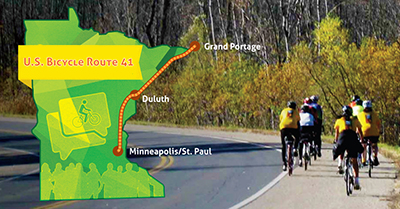 |
|

|
 |
TABLE of CONTENTS
 |
Diverging diamond coming to western Minnesota |
By Jerimiah Moerke, District 4 public affairs coordinator

Hwy 75/Eighth Street and the east side ramps to and from Interstate 94 closed on June 6. Crews are working to reconstruct the bulk of the interchange area before colleges open again this August. Photo by Jerimiah Moerke |
The city of Moorhead is a sea of orange this year. It’s in the midst of one of its busiest construction seasons ever. City streets, state highways, interstate and railroad crossings are all affected.
District 4 is leading one of the largest projects, an interchange reconstruction at Interstate 94 and Hwy 75/Eighth Street on the south side of the city.
More than 200,000 people live in the Fargo-Moorhead area, and the population growth is putting a strain on the transportation network in parts of Moorhead.
The interchange is the busiest in District 4, and it’s been a source of angst for many residents.
“We’ve heard many complaints over the years from people who drive back and forth between Fargo and Moorhead,” said Jody Martinson, district engineer. “So many people use that interchange for work, school or shopping, and the delays and backups get very frustrating.”
To help alleviate those concerns, MnDOT is converting the interchange to a diverging diamond. It will be new to the Fargo-Moorhead area and to western Minnesota.
The overall project includes a total reconstruction of the interchange. Everything will be removed and reconstructed except for the Hwy 75 bridges over I-94, which are only about 15 years old. In addition, crews are constructing auxiliary lanes on I-94 between Hwy 75 and the next interchange at 20th Street.
In early outreach efforts, District 4 was concerned about whether or not the public would support a new interchange concept.
“We thought we’d hear much more concern or even opposition to the diverging diamond design,” said Seth Yliniemi, project manager. “But instead, people who live in the area generally supported it.”
It didn’t hurt that analysis showed the diverging diamond would operate more efficiently and cost less than adding traditional loop ramps.
The project is set to be completed in the 2016 construction season, which is a tight schedule.

Crews began work on the new I-94 auxiliary lanes in April. Any work on I-94 requiring lane closures takes place overnight to reduce backups on the interstate. Photo by Jerimiah Moerke |
Because traffic volumes are lower in the summer, the bulk of the work will be completed between June and August. That also means bigger headaches for local drivers during those months.
Much of the interchange closed on June 6, so drivers are still working out new routes to get to and from work.
The tradeoff for the community is more traffic pain for the summer for a project with a shorter duration. By closing more of the interchange, work will progress faster. The contractor must open the interchange by mid-August when three local colleges start classes again.
Sellin Brothers of Hawley is the prime contractor for the $13.6 million project.
More information about the project is available at www.mndot.gov/d4/projects/moorhead.
|
 |
|

|
 |
TABLE of CONTENTS
 |
District 8 hosts equipment demo day |
This video covers the Equipment Demo Day organized by MnDOT's Maintenance Office and District 8 maintenance crew. The event was held at District 8's headquarters in Willmar on May 18. Video produced by Rich Kemp and Sue Roe |
|
 |
|

|
 |
TABLE of CONTENTS
 |
Agency works to develop new U.S. bicycle route 41 |
|
By Sue Roe

The Bicycle and Pedestrian office is working with the public to develop a plan for U.S. Bicycle Route 41 between St. Paul and Grand Portage. |
The state’s next U.S. Bicycle Route will connect existing roads and trails between St. Paul and Grand Portage State Park. The Bicycle and Pedestrian office held four public open houses this month to give people the opportunity to help identify which roads and trails should connect to create the new route.
An online survey and mapping tool are also available for people to comment at www.mndot.gov/bike/usbr41. Deadline to comment is June 23.
The route will be approximately 325 miles long and expand tourism opportunities by connecting with the state’s other designated U.S. Bicycle Route, the Mississippi River Trail/U.S. Bicycle Route 45. Minnesota’s segment of the 10-state MRT follows the Mississippi River from the headwaters at Itasca State Park near Bemidji to the Iowa border. The entire MRT extends 3,000 miles to the Gulf of Mexico.
U.S. Bicycle Route 41 was identified as a high priority corridor in the Statewide Bicycle System Plan.
Liz Walton, project manager, said the route will use existing local and regional trails and roadways.
“By connecting existing facilities we can have a route that’s ‘ride-ready’ in a short time," said Walton. "We’d like the public’s help in deciding which roads and trails are best for bicycling. We’ll develop something for everyone. A U.S. bicycle route connects people, places and the things people love by bicycle. It creates an opportunity for a short local ride across town with friends or one across the country on an official bicycle route.”
The U.S. Bicycle Route 41 project is intended to complement local bicycle planning. It will be a route of partnerships developed with adjacent network connections in mind and is intended to build upon communities’ efforts, help move local bicycle plans forward and benefit communities and bicyclists alike.
Once public input is collected, MnDOT will develop a draft route and map, and schedule a second round of public meetings for final review and comments. Walton said she anticipates the route will receive official designation in the fall.
U.S. Bicycle Routes are numbered corridors of routes that will connect between states. To date, more than 11,000 miles of U.S. Bicycle Routes are established in 24 states. The goal is to develop a 50,000 mile network. |
 |
|

|
 |
TABLE of CONTENTS
 |
Project Management Battle wraps up successful EFE WIG |
By Judy Jacobs

The Project Management Battle team was able to balance project letting schedules as part of its Wildly Important Goal. Before the team began work on the goal, more than half of the projects were advertised for bid in the fourth quarter. |
When MnDOT kicked off its Enhancing Financial Effectiveness Wildly Important Goal in November 2013, the Project Management Battle team was asked to look at ways to balance project letting schedules.
The team was co-chaired by Nancy Daubenberger, assistant commissioner, Engineering Services division, and Mike Barnes, assistant commissioner, Operations Division. Working with project leaders Tom Styrbicki, Project Management and Technical Support director and state design engineer; and Chris Roy, assistant division director, Engineering Services, they focused their efforts on optimizing the letting schedule so that project lettings were more evenly distributed throughout the fiscal year.
“A large part of MnDOT’s core business is delivering the state’s road construction projects,” Barnes said. “The public expects us to plan, build and maintain this system efficiently and effectively and to deliver quality projects on time and on budget.”
Prior to the Enhancing Financial Effectiveness WIG, more than half of MnDOT‘s construction projects were advertised for bid in the fourth quarter of the fiscal year. This created an uneven workload and a less favorable situation for bidding. By that time, many contractors were either unavailable or submitted higher bids to compensate for resource challenges. The Project Management Battle Team focused on distributing the majority of project lettings in the first three quarters of the fiscal year.
To achieve the balanced letting goal, a lead measure was developed for projects in negative float, an indicator that some project activities may not be completed on schedule. The negative float scorecard was reviewed weekly and PM Battle Team members made individual commitments to improve performance.
“The cadence of accountability was important,” Styrbicki said. “It kept us focused on proactive schedule management and project team coordination. We found that negative float is not inherently bad, it‘s just an indicator that a project manager needs to address an issue or work with a project team member to keep the project moving forward. Through the Enhancing Financial Effectiveness initiative, we’ve been able to make fundamental improvements in how we do business.”
As a result of this effort, 80 percent of projects were let prior to the last quarter of FY 2016. This is a significant improvement over FY 2014 when only 44 percent of projects were let prior to the fourth quarter. This positive trend is expected to continue, given the strong emphasis on schedule management and project team coordination that is now part of MnDOT’s project delivery methodology.
The feedback from contractors is that this new process helps them be more efficient and effective in the way they assign their resources to deliver projects.
“We’ve gotten people to think differently about how a project is delivered,” said Roy. “It’s a new way of thinking that has resulted in a culture change.”
Another important initiative by the Project Management Battle team was to more closely manage project scope and cost. Emphasis was placed on quality scoping and risk analysis for projects entering the program. More work is going to be done to advance MnDOT in cost management beyond the Project Management Battle.
“We were excited to see how quickly MnDOT employees adopted the Project Management battle,” said Daubenberger. “There is an incredible amount of pride of accomplishment, innovation and a willingness to share information across work groups and divisions. Possibly the biggest benefits that resulted from the Project Management Battle are the culture shift toward earlier coordination on P6 schedules, and the elevated importance of holding letting dates or working together to swap projects’ lettings to maintain balance in the program. We’ve made great strides, but we’re not done yet.” |
 |
|

|
 |
TABLE of CONTENTS
 |
Transportation Information System mainframe to shut down at end of June |
|
By Christy Prentice, Office of Transportation System Management
After decades of use, the Transportation Information System mainframe will be shut down the last week of June and replaced with the new Linear Referencing System. The TIS system, which is no longer aligned with MnDOT standard technologies or strategic technology investments, has been frozen since Jan. 28, 2014. Most user access to the data will not be affected because the data is still available in the datasets produced from TIS. However, if you are a user of the TIS system or its derivative Oracle subsystems, there will be effects since the TIS access and accounts are being turned off.
The TIS system provided core mileage and reference locations and contained six subsystems:
- Bridge
- Pavement
- Roadway characteristics
- Crash
- Traffic
- Roadway history
What does this mean if you use TIS?
- Your TIS login account will be disabled
- You will no longer be able to access the TIS Mainframe or its derivative Oracle subsystem(s)
- You will no longer be able to run reports or analytics using the TIS system
In addition to TIS, the GIS BaseMap data is also no longer being updated; frozen copies of both the GIS BaseMap and TIS will be available for those who need them. For information about the LRS, check out the LRS webpage.
Contact Peter Morey 651-366-3872 if you have any questions. |
 |
|

|
 |
TABLE of CONTENTS
 |
Pilot training program offers opportunities for employment |
By Judy Jacobs

Jeremy Ammesmaki, Fond du Lac tribe, and his family receive a plaque for graduating from the CDL course. Ammesmaki was hired by MnDOT in District 1. Photo by Tom Urbanski, Fond du Lac Community College |
Using a grant from MnDOT’s Office of Civil Rights, the Fond du Lac Tribal and Community College offered its tribal members a 12-week training course to help students obtain their Class A commercial driver’s license. Having a CDL will increase students’ opportunities for employment. Thirteen students participated in the initial program.
The intent of the program is to train women, minorities and disadvantaged individuals in the skills they need to obtain a commercial driver’s license and related skills to gain entry level highway heavy construction, on-the-job training positions with contractors working on MnDOT federal aid projects, local government agencies, or entry-level Transportation Specialists Series positions with MnDOT.
The training started through a tribal-state partnership under the leadership of Carol Logan and Maria Conley, Office of Civil Rights, and the Tribal Employment Rights Office from Fond du Lac, Bois Forte and Mille Lacs Band. Cindy Bellefeuille, MnDOT Tribal Affairs, and District 1 staff provided additional support.
On April 8, Fond du Lac Tribal and Community College held a graduation ceremony. Nine of the graduates were offered immediate employment; MnDOT hired one student.

Commissioner Charlie Zelle received an award from Craig Hansen, Great Lakes Region TERO chairman, June 3 for MnDOTís efforts in the CDL training at Fond du Lac Community College. Present for the presentation were (from left) Zelle; Kim Collins, Office of Civil Rights director; Cindy Bellefeuille, MnDOT Tribal Affairs; Hansen; Patty Petite, Fond du Lac Community College; Don Carlson, Fond du Lac Community College; and Ed Fairbanks, MnDOT Tribal liaison. Photo by Judy Jacobs |
The CDL training program will be taught at other tribal colleges, with the next one at Leech Lake Tribal College, hosted by the Leech Lake Reservation, working in a partnership with District 2. Students will be recruited from Leech Lake, Red Lake and White Earth reservations and tribal populations living in surrounding non-tribal towns.
Fond du Lac Tribal Community College representatives will work closely with the Office of Civil Rights, Tribal Affairs, District 2 and TERO officers from the three reservations.
“This amazing workforce development opportunity will have a long-term effect on our tribal members,” said Dr. Patty Petite, interim dean of career and technical education and workforce development at Fond du Lac Tribal and Community College. “It was interesting to watch the boost in the students’ confidence levels as they learned the skills they needed to provide them career opportunities and not just a job.”
Representatives from Fond du Lac Tribal and Community College presented a plaque June 3 to Commissioner Charlie Zelle in appreciation and recognition of MnDOT’s efforts to support the program. |
 |
|

|
|

|
 |
TABLE of CONTENTS
 |
Animated videos, annual report, graphics work net four awards for agency communicators |

Beth Petrowske, District 1 public affairs coordinator, received an award from the Minnesota Association of Government Communicators for a photo illustration depicting the theme of teamwork. |
MnDOT communicators from Metro District, District 1 and Central Office received a total of four awards from the Minnesota Association of Government Communicators at the annual Northern Lights Awards Reception, held May 19 in Bloomington.
The awards recognize outstanding work in government, education and nonprofit communications.
MnDOT award winners were:
- Metro District Communications and Engagement Office, which received the Northern Lights Award (the top prize) in the Video Campaign or Series category and was a Best of Show Nominee for its Enhance Interstate 694 Animated Campaign. The campaign consisted of three videos that aired in advance of (and during) construction work to help explain traffic flow through the I-694 work zone. The videos are part of a larger social media strategy for the construction project. A combination of MnDOT and consultant staff worked on the campaign, including Chris Krueger, Metro Communications and Engagement director; Kent Barnard, public affairs coordinator; Josh Van Den Berg, business liaison; and Mark Lindeberg, I-694 project manager. These individuals worked with consultant HDR’s strategic communications team.
- Office of Communications, which received the MAGC Silver Award in the Logo, Illustration or Graphic category for the Minnesota Go Mobile exterior design. (MnDOT uses the van as a mail delivery vehicle by day and as a pop-up public engagement booth at community events on evenings and weekends.) The design covers the outside of the van, and was created as an erasable coloring book that invites children to color transportation-related items and activities while MnDOT staff engage with their parents (e.g., providing feedback, taking surveys, etc.). The design can be peeled off the van and replaced with a new engagement theme, as needed. Adam Oie, graphic artist, working with the Office of Customer Relations (now Public Engagement & Constituent Services), created the design.
- Office of Communications, which tied for the MAGC Bronze Award in the Annual Report category for the 2014-15 Annual Winter Maintenance Report. Using infographics and short sections of text, the report provides a summary of the previous winter’s maintenance activities and costs, including statewide average snowfall total, the amount of sand and salt used, and materials and labor costs. Sue Roe, public affairs program administrator, and Adam Oie, graphic artist, worked with Office of Maintenance staff to produce the report.
- District 1/Duluth, received an Award of Merit in the Logo, Illustration or Graphic category for a photo illustration depicting the theme of teamwork that was used as part of a District 1 employee meeting in May 2015. Beth Petrowske, public affairs coordinator, designed the illustration, which includes photos of bright orange balloons and District 1 employees holding graphic letters that spell “teamwork.”
Find more information about the MAGC awards here. |
 |
|

|
 |
TABLE of CONTENTS
 |
Whatís new on the web |
By Becky Niyukuri

Weekend traffic map for Greater Minnesota. |
Statewide weekend traffic impacts
Traveling in Greater Minnesota this summer? Wherever you’re headed, we’ve got you covered with an overview of significant weekend traffic impacts across the state.
Similar to Metro weekend traffic impacts, the new statewide weekend traffic webpage has a map and list of projects that might affect travel and help motorists plan ahead.
The map is updated weekly. Scope it out at mndot.gov/statewidetrafficimpacts.
You can also check www.511mn.org for real-time traffic conditions, and sign up for email updates on projects happening close to home or work. |
 |
|
| |
|



